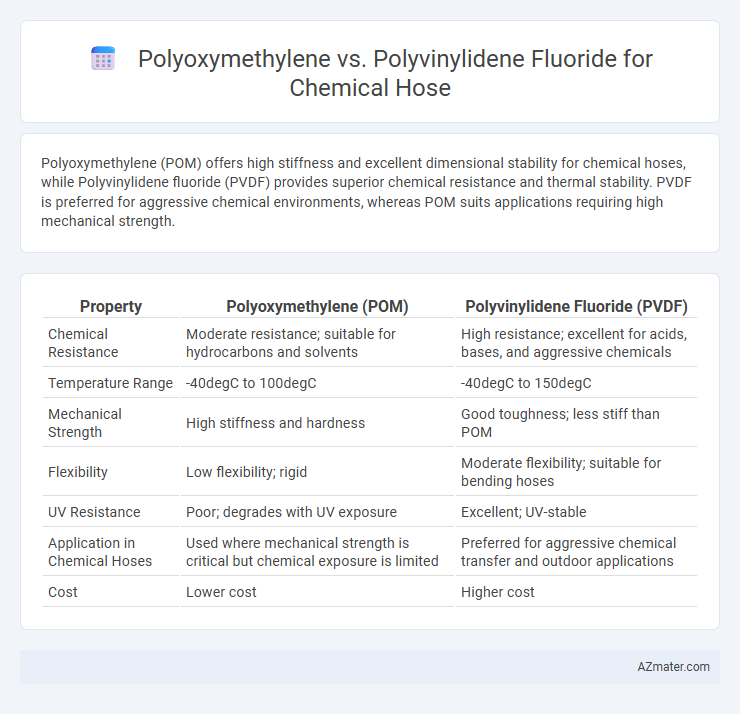Polyoxymethylene (POM) offers high stiffness and excellent dimensional stability for chemical hoses, while Polyvinylidene fluoride (PVDF) provides superior chemical resistance and thermal stability. PVDF is preferred for aggressive chemical environments, whereas POM suits applications requiring high mechanical strength.
Table of Comparison
| Property | Polyoxymethylene (POM) | Polyvinylidene Fluoride (PVDF) |
|---|---|---|
| Chemical Resistance | Moderate resistance; suitable for hydrocarbons and solvents | High resistance; excellent for acids, bases, and aggressive chemicals |
| Temperature Range | -40degC to 100degC | -40degC to 150degC |
| Mechanical Strength | High stiffness and hardness | Good toughness; less stiff than POM |
| Flexibility | Low flexibility; rigid | Moderate flexibility; suitable for bending hoses |
| UV Resistance | Poor; degrades with UV exposure | Excellent; UV-stable |
| Application in Chemical Hoses | Used where mechanical strength is critical but chemical exposure is limited | Preferred for aggressive chemical transfer and outdoor applications |
| Cost | Lower cost | Higher cost |
Introduction to Chemical Hose Materials
Polyoxymethylene (POM) offers high mechanical strength and excellent dimensional stability, making it suitable for chemical hose applications requiring durability and resistance to wear. Polyvinylidene fluoride (PVDF) excels in chemical resistance, especially against strong acids, bases, and organic solvents, ensuring hose integrity in aggressive environments. Selecting the appropriate material depends on balancing mechanical properties and chemical compatibility tailored to specific industrial fluid transfer needs.
Overview of Polyoxymethylene (POM)
Polyoxymethylene (POM), also known as acetal, is a high-performance engineering thermoplastic characterized by excellent mechanical strength, stiffness, and low friction. Its superior chemical resistance to solvents, fuels, and hydrocarbons makes POM suitable for chemical hose components exposed to aggressive fluids. Compared to Polyvinylidene fluoride (PVDF), POM offers enhanced dimensional stability and wear resistance, although PVDF excels in extreme chemical and temperature resistance for highly corrosive applications.
Overview of Polyvinylidene Fluoride (PVDF)
Polyvinylidene Fluoride (PVDF) is a highly non-reactive and pure thermoplastic fluoropolymer with excellent chemical resistance, making it ideal for chemical hose applications where aggressive fluids are present. PVDF offers superior resistance to acids, bases, and solvents compared to Polyoxymethylene (POM), along with strong mechanical properties and excellent UV stability. Its durability in harsh environments and resistance to permeation enhance the lifespan and safety of chemical transfer systems.
Chemical Resistance Comparison: POM vs PVDF
Polyvinylidene fluoride (PVDF) exhibits superior chemical resistance compared to polyoxymethylene (POM), particularly against strong acids, bases, and organic solvents, making it more suitable for aggressive chemical hose applications. POM tends to degrade or swell when exposed to chlorinated solvents and concentrated acids, limiting its use in harsh chemical environments. PVDF's enhanced resistance to a broad spectrum of chemicals ensures greater durability and longevity in chemical hose manufacturing.
Mechanical Properties and Durability
Polyoxymethylene (POM) exhibits high stiffness, excellent dimensional stability, and strong mechanical strength, making it suitable for chemical hoses requiring rigidity and wear resistance. Polyvinylidene fluoride (PVDF) offers superior chemical resistance, excellent impact strength, and UV stability, enhancing durability in aggressive chemical environments and outdoor applications. While POM provides better load-bearing capacity, PVDF outperforms in long-term chemical exposure and environmental aging, ensuring extended service life for chemical hose systems.
Temperature Tolerance and Thermal Stability
Polyoxymethylene (POM) offers moderate temperature tolerance with a maximum continuous use temperature around 100degC, making it suitable for chemical hoses exposed to mild thermal conditions. In contrast, Polyvinylidene fluoride (PVDF) excels in thermal stability, sustaining continuous operation at temperatures up to 150degC while resisting thermal degradation in harsh chemical environments. PVDF's superior heat resistance and chemical inertness position it as the preferred material for high-temperature chemical hose applications requiring long-term stability.
Flexibility and Ease of Hose Fabrication
Polyoxymethylene (POM) offers superior rigidity but limited flexibility compared to Polyvinylidene fluoride (PVDF), making PVDF more suitable for applications requiring intricate hose bending and maneuverability. PVDF's chemical resistance combined with its higher flexibility facilitates easier hose fabrication, especially in complex routing scenarios. POM's stiffness can hinder ease of manufacturing complex hose assemblies, whereas PVDF supports smoother fabrication processes due to its elastomeric properties.
Cost Analysis and Availability
Polyoxymethylene (POM) offers a lower cost compared to Polyvinylidene fluoride (PVDF), making it a budget-friendly option for chemical hose applications. PVDF, while more expensive, provides superior chemical resistance and durability, justifying its cost for specialized use cases. Availability of POM is widespread due to its extensive industrial use, whereas PVDF availability can be more limited, often depending on supplier and geographic location.
Typical Applications in Chemical Handling
Polyoxymethylene (POM) excels in chemical hose applications requiring high mechanical strength and excellent abrasion resistance, commonly used for handling solvents, detergents, and mild acids. Polyvinylidene fluoride (PVDF) offers superior chemical resistance and thermal stability, making it ideal for aggressive chemicals such as strong acids, alkalis, and organic solvents in chemical processing industries. Both materials are chosen based on specific chemical compatibility and operational temperature requirements, ensuring safe and efficient fluid transfer in industrial environments.
Choosing the Right Material: POM or PVDF?
Polyvinylidene fluoride (PVDF) offers superior chemical resistance and temperature stability compared to Polyoxymethylene (POM), making it ideal for chemical hose applications involving aggressive acids or solvents. Polyoxymethylene provides greater mechanical strength and stiffness but is more prone to chemical degradation when exposed to certain solvents and high temperatures. Selecting PVDF ensures enhanced durability and longevity in harsh chemical environments, while POM suits applications prioritizing rigidity and wear resistance under mild chemical exposure.

Infographic: Polyoxymethylene vs Polyvinylidene fluoride for Chemical hose
 azmater.com
azmater.com